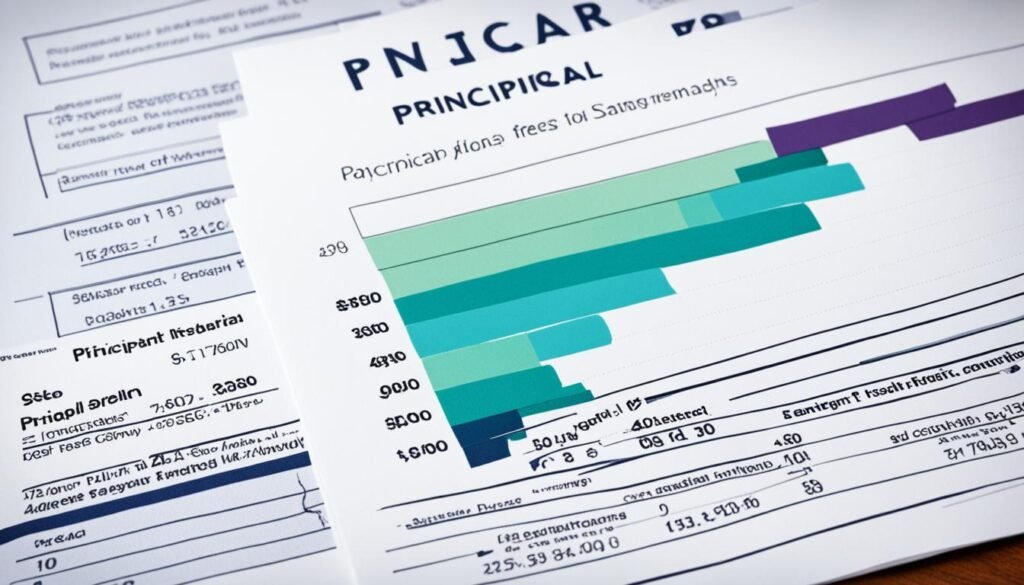The loan principal is the money you originally borrow through a loan. Unlike the loan interest, it’s not the cost of borrowing. It’s the first amount of money you receive from the lender. Interest is the additional fee for using that money.
It’s important to know the difference between loan principal and interest. This knowledge is key to smart financial handling. It applies whether you’re getting a mortgage, a personal loan, a student loan, or managing savings for retirement.
Key Takeaways
- The loan principal is the original amount of money borrowed via a loan.
- The loan principal is distinct from the loan interest, which is the cost of borrowing the principal amount.
- Understanding the definition of loan principal is crucial for managing your finances effectively.
- The loan principal is the initial sum of money you borrow, while the interest is the additional cost you pay the lender.
- Comprehending the role of the principal of a loan and how it differs from interest can help you make informed decisions about your borrowing and repayment strategies.
Understanding the Loan Principal
When you take a loan, understanding the “loan principal” is key. The loan principal is the initial amount you borrow from a lender. It includes the money you took and have to pay back, not the extra fees over time.
Loan Principal Definition
The loan principal is like the loan’s starting point. It’s the base sum before any interest or fees get added. This core amount gets smaller as you make payments on the loan.
Loan Principal vs. Loan Principle
“Loan principal” and “loan principle” might seem alike but they’re not. The loan principal is the loan’s original amount. The loan principle means an important rule in the lender’s decision making. Knowing this helps you understand your loan and payments well.
“The loan principal is the core amount of the loan that you are responsible for repaying, distinct from the interest charges you’ll pay over the life of the loan.”
It’s crucial for borrowers to tell the difference between the loan principal and loan principle. This knowledge helps them make smart financial choices and handle their loans better.
Also Read : Is A Personal Loan The Right Choice For You?
Loan Principal Vs Interest

In loans, the loan principal and loan interest are key. They form your monthly payments. It’s important to know these for good financial management. The main thing to remember is this:
The loan principal is the amount you borrowed. The loan interest is what you pay for borrowing that. Each month, part of your payment goes to the principal and part to the interest.
In the loan’s early phase, you pay more interest. But over time, you pay more on the principal. This happens because as you pay, the remaining balance (and thus, the interest on it) gets smaller.
Let’s show the difference with an example:
- You borrow $100,000 at a 5% interest for 30 years.
- Your first month’s payment might be $536.82. Of that, $416.67 is interest and $120.15 is principal.
- By the 100th month, it flips. You now pay $120.15 in interest and $416.67 on the principal.
- Over the loan’s life, you pay $193,245. Of this, $93,245 is interest.
Getting the difference helps you be smarter with your money. This understanding can lead to better loan and repayment choices and improve your financial future.
Also Read : How Does Insurance Protect Me?
Principal Payments and Interest Payments

Loan payback can have different blends of principal and interest parts. The two main methods are even principal payments and even total payments.
Even Principal Payments
In this plan, the money for principal payments is the same every month. But the interest payments lessen over time. So, your total monthly payment drops as you pay more to lower your debt.
Even Total Payments
With even total payments, you keep paying the same amount each month. Still, the part that goes to principal payments increases. The amount for interest payments gets smaller as time goes on.
| Loan Repayment Plan | Principal Payments | Interest Payments | Total Monthly Payment |
|---|---|---|---|
| Even Principal Payments | Constant | Decreasing | Decreasing |
| Even Total Payments | Increasing | Decreasing | Constant |
Choosing between these plans greatly affects your loan cost and how you manage your money. Knowing these differences is key when picking the best option for you.
Also Read :What Are Asthma Symptoms?
How Your Monthly Mortgage Payment Works

To understand your monthly mortgage payment, you need to look at a few key parts. This payment is made up of the loan principal, the interest, mortgage insurance if you have it, and money put into escrow each month. Escrow is for property taxes and homeowners insurance.
The loan principal is what you borrowed to buy your home. It stays the same in your payments. The interest is based on your rate and the loan’s balance.
If you use mortgage insurance, the cost shows in your monthly mortgage payment breakdown. This insurance protects the lender if you can’t pay back the loan.
Escrow takes care of future property taxes and insurance. This part of your payment can change, for example, if your home’s value goes up and so do your taxes.
Understanding the monthly mortgage payment breakdown is key to handling homeownership costs. Knowing each part helps you manage your budget and choices.
“Knowing the details of your monthly mortgage payment can help you budget effectively and avoid any surprises down the road.”
Also Read :How Do You Navigate The Loan Application Process Successfully?
Loan Principal on Your Statement

It’s key to know the loan principal when handling your debts. Your lender will break down payments on things like a mortgage or student loan. This breakdown includes what part goes to the loan principal.
Seeing the loan principal on your statement shows you how much you’ve paid off from the original loan. It’s valuable for understanding your financial progress. This helps with plans like paying faster or finding lower interest rates through refinancing.
Finding the loan principal on your statement is easy. Look for a part that details your monthly payment settings. It shows the principal amount and how much is interest.
| Loan Details | Amount |
|---|---|
| Original Loan Amount | $200,000 |
| Current Loan Balance | $175,000 |
| Principal Paid This Month | $500 |
| Interest Paid This Month | $700 |
In the above example, $500 went to loan principal and $700 to interest. Keeping track of these figures helps you see how you’re doing.
If you don’t understand your loan statement, contact your lender. They can help you grasp your loan principal. This support will let you make better choices about your money.
Also Read :What Are The Different Types Of Insurance?
Loan Principal in Investing and Business
In investing and business, the idea of loan principal goes further than personal loans. It’s the original sum you invest, like in a 401(k) plan. In business, “principal” means the main owners or teams in a big deal.
Knowing about loan principal helps in making smarter choices in investing and business. Let’s dive into how loan principal matters in these fields:
Loan Principal in Investing
Loan principal in investing is the first chunk of money you invest. It can be what you put in a retirement account. Or what you use to buy stocks and bonds through a broker.
This amount is where your investment’s growth is based. As your investments make money, your principal grows too. Watching your loan principal grow helps in managing your investments better.
Loan Principal in Business
In business, “principal” talks about key owners or decision-makers. They guide the business and make important choices. They are the heart of the business’s success.
In business deals, like loans or contracts, loan principal plays a big part too. It’s the original amount you borrow or invest. Then, you pay it back with added interest. Businesses need to understand this to pick the best financial deals.
Learning about loan principal in investing and business is key. It lets you be wiser with your money. This is useful whether it’s for personal gain or running a business.
Also Read :How To Boost Your Credit Score For Better Loan Options
Loan Principal Amortization

Loan principal amortization is how loan payments get divided into principal and interest. This division changes over time. At first, most of your payment covers interest. Later on, the part that goes to the loan principal grows.
Knowing about loan principal amortization helps with your budgeting. It shows you how your payments lower your debt. Then, you can plan to pay off the loan quicker or change your budget.
The Amortization Schedule
An amortization schedule is like a guide for your loan payments. It tells you how much goes to the principal and how much to interest each time. Plus, it shows how much you still owe after each payment.
- The amount of the payment allocated to loan principal
- The amount of the payment allocated to interest
- The remaining balance on the loan principal after each payment
| Payment # | Payment Amount | Principal Paid | Interest Paid | Remaining Principal |
|---|---|---|---|---|
| 1 | $500 | $200 | $300 | $9,800 |
| 2 | $500 | $202 | $298 | $9,598 |
| 3 | $500 | $204 | $296 | $9,394 |
| 4 | $500 | $206 | $294 | $9,188 |
There are tools online to help you understand loan principal amortization. Or you can ask your lender. They can explain how your specific loan’s schedule works. This helps you know when you’ll finish paying off your loan.
“Knowing your loan principal amortization is key to managing your debt and planning for the future.”
Being up-to-date on your loan principal amortization makes it easier to handle your debt. It also helps you plan better for your financial future.
Paying Down the Loan Principal

Besides your monthly mortgage, you might be able to add more to your loan’s principal. This option lets you pay off the loan principal quicker. It also cuts down the interest amount you owe over time.
But, not every lender lets you do this. It’s key to check with your lender before sending extra payments. Make sure they’re fine with it and know what their rules are.
The Benefits of Principal-Only Payments
There are many pluses to focusing on the loan principal with principal-only payments:
- It can end your loan earlier, saving you lots of interest.
- You’ll pay less in interest over the loan’s life.
- It helps you own more of your home sooner.
- The loan costs you less in the end.
By putting extra money towards the loan principal, you manage your money better. This way, you get rid of debt sooner.
| Scenario | Regular Payments | Principal-Only Payments |
|---|---|---|
| Loan Amount | $200,000 | $200,000 |
| Interest Rate | 4.5% | 4.5% |
| Loan Term | 30 years | 30 years |
| Monthly Payment | $1,013 | $1,013 |
| Total Interest Paid | $164,759 | $105,729 |
| Loan Payoff Time | 30 years | 21 years, 6 months |
This table shows how adding $100 extra to your $200,000 loan each month can change things. With $100 more in principal-only payments, you could save $59,000 in interest. Plus, you’d finish paying nearly 9 years early.
“Making principal-only payments is a smart way to lower your loan’s total cost and own more of your home fast.”
Loan Principal

The loan principal is key in personal finance and business lending. It’s the first amount of money you borrow for a loan, with no extra interests or fees yet. Knowing this is vital for handling debt, investments, and planning your finances.
When you borrow money, like for a house, personal needs, or school, you’re responsible for the loan principal. This is the main amount you have to pay back. It’s used to figure out the interest you owe and the total loan cost.
Understanding what the loan principal is and how it’s different from the interest is important. It helps you make better financial choices. You can manage debt, plan your budget, and make the most of your savings and investments when you understand this.
The Importance of the Loan Principal
The loan principal is key because:
- It sets the total you must repay, influencing your monthly payments and the loan’s cost.
- The interest you owe is based on the loan principal. This knowledge can help you predict and handle your interest payments.
- Lowering the principal reduces how much interest you pay. This could save you a lot of money over time.
- For investments, the principal is the start of what can grow through compound interest or investment returns.
Knowing the loan principal and interest helps you make smart money decisions. This improves how you deal with debt and manage your investments better.
Maximizing Your Loan Principal
Want to make the most out of your loan principal? Here’s how:
- Make extra payments on the principal to cut down the loan amount and interest over time.
- Look into refinancing to drop your interest rate. This way, more of what you pay goes to the principal.
- Boost your monthly payments to pay it off quicker and lower the interest total.
- When getting a new loan, check the terms. Less fees and a lower principal are better for you.
By working on your loan principal, you can manage your money well. This can lessen your debt, boosting the benefits of your loans and investments in the long run.
Also Read : Can I Get An Upgrade Loan For Home Improvements?
Conclusion
Understanding the loan principal is key in managing your money wisely, whether you’re borrowing or investing. The loan principal is the original amount you borrowed. Interest is the extra you pay for borrowing that money.
Knowing about the loan principal and interest helps you reach your money goals faster and avoids big mistakes. It gives you the power to make smart choices about borrowing and paying back. This can lead to a prosperous future.
Keeping up with the loan principal helps you make better money decisions. It’s a skill that will always be useful for your financial health. Understand the loan principal and take charge of your financial future.
FAQs
What is a Loan Principal?
The loan principal is the money you originally borrowed from a loan. It’s not the same as the interest. Interest is the extra charge for borrowing the principal.
What is the difference between Loan Principal and Loan Principle?
The loan principal is the amount of money borrowed. On the other hand, “principle” means a moral rule. It’s essential to understand the difference to know your loan’s terms.
How do Loan Principal and Loan Interest differ?
Loan principal is the original amount you borrow. Interest is the extra money you pay to the lender for borrowing. Payments cover both the loan and the interest.
What are Even Principal Payments and Even Total Payments?
In even principal payments, the amount for the principal stays the same every month. But, the interest part changes. Even total payments plan keeps the overall monthly payments constant. However, the portion that goes to the principal and interest shifts.
How is a Monthly Mortgage Payment Broken Down?
Your monthly mortgage payment covers the loan principal, interest, and possibly mortgage insurance. It can also include escrow for taxes and insurance for your home.
Where can I see the Loan Principal on my Statement?
Your loan statement details your payment breakdown. It includes the sum towards the loan principal. By checking this, you can see how much goes to the original loan versus the interest.
How is Loan Principal used in Investing and Business?
For investing, principal means the original money invested, like in a retirement account. In business, it can mean the company’s main owners or stakeholders. It can also refer to key participants in big dealings.
How does Loan Principal Amortization work?
Amortization figures out how each payment affects the loan principal and interest. An amortization schedule shows this split, with more going to interest at first. Later, more will go towards the loan amount.
What are Principal-Only Payments?
With principal-only payments, you put money only towards the loan principal. This can make you debt-free sooner and lower the total interest cost.
Source Links
- https://www.checkcity.com/loans-101/loan-principal-explained
- https://www.consumerfinance.gov/ask-cfpb/on-a-mortgage-whats-the-difference-between-my-principal-and-interest-payment-and-my-total-monthly-payment-en-1941/
- https://www.creditkarma.com/personal-loans/i/what-is-a-loan-principal




